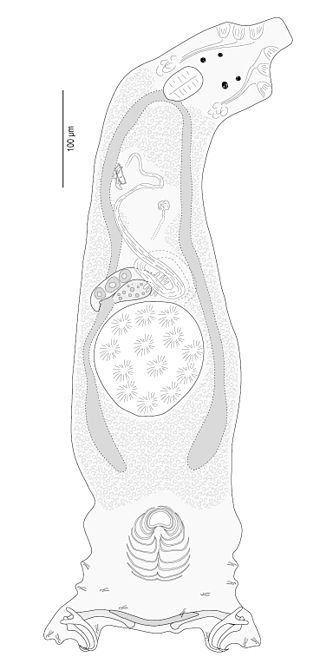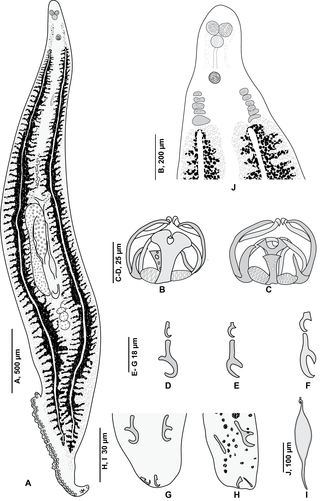
Microcotyle is a genus which belongs to the phylum Platyhelminthes and class Monogenea. Species of Microcotyle are ectoparasites that affect their host by attaching themselves as larvae on the gills of the fish and grow into adult stage. This larval stage is called oncomiracidium, and is characterized as free swimming and ciliated.

Gyrodactylidae is a family of flatworms in the order Gyrodactylidea.

Gyrodactylus is a genus of parasitic flatworms in the family Gyrodactylidae.

Opecoelidae is a family of trematodes. It is the largest digenean family with over 90 genera and nearly 900 species, almost solely found in marine and freshwater teleost fishes. It was considered by Bray et al. to belong in the superfamily Opecoeloidea Ozaki, 1925 or the Brachycladioidea Odhner, 1905.

Pseudorhabdosynochus is a genus of monopisthocotylean monogeneans, included in the family Diplectanidae. The type-species of the genus is Pseudorhabdosynochus epinepheli .

The Diplectanidae are a family of monopisthocotylean monogeneans. They are all parasitic on the gills of fish. Diplectanids are small animals, generally around 1 mm in length. As parasites, they can be extremely numerous, up to several thousand on an individual fish.
Alexandr Vladimirovich Gussev, sometimes spelled Gusev in the literature, was a Russian helminthologist specialist of monogeneans.
Hexabothriidae is a family of monogenean parasites. The family name was proposed by Emmett W. Price in 1942. The family includes 14-16 genera according to authors and about 60 species; all are parasitic on the gills of chondrichthyan fishes.
Gyrodactylus leptorhynchi is a small monogenean obligate ectoparasite which parasitizes freshwater bay pipefish. Gyrodactylus leptorhynchi is the seventh Gyrodactylus species known to infect bay pipefish and the first characterized along the Pacific coast of North America. The parasite can get into captive fish environments, such as fish farms and aquariums, where it may spread in as little as 10 days. Gyrodactylus species are known to centralize on the brood pouch in male fish, this may allow for transmission to newly hatched young. However, in Gyrodactylus leptorhynchi the parasite was found mostly found attached to body surfaces such as the dorsal fins.

Lamellodiscus is a genus of monopisthocotylean monogeneans in the family Diplectanidae; all species of Lamellodiscus are small worms, parasitic on the gills of teleost fish.
Polyclithrum is a genus of monogeneans in the family Gyrodactylidae.
Swingleus is a genus of monogeneans in the family Gyrodactylidae. It consists of two species, Swingleus polyclithroides Rogers, 1969. and Swingleus ancistrus Billeter, Klink & Maugel, 2000. Swingleus has been reported from the skin and fins of Fundulus grandis and Fundulus heteroclitus but not from the gills. S. polyclithroides was reported from Mobile Bay, AL and S. ancistrus has been reported from Fundulus heteroclitus ranging from Long Island Sound, NY to Pamlico Sound, NC.

Ancyrocephalidae is a family of monogenean flatworms. The family is considered as a "temporary name" in WorMS but includes a large number of genera and species.
Anchoradiscoides is a genus of monogeneans belonging to the family Ancyrocephalidae. All members of the genus are parasitic on North American centrachid fish.
Delane C. Kritsky is an American parasitologist who specialised on the Monogenea, a class of parasitic flatworms which are important ectoparasites of fishes. His research was mainly in the fields of taxonomy, faunistics, and phylogeny of the Monogenea.

Jean-Lou Justine, French parasitologist and zoologist, is a professor at the National Museum of Natural History in Paris, France, and a specialist of fish parasites and invasive land planarians.

Microcotyle archosargi is a species of monogenean, parasitic on the gills of a marine fish. It belongs to the family Microcotylidae. It was first described by MacCallum in 1913 based on ten specimens. Hargis (1956) pointed out that the description and figures given by MacCallum were poor in details.
Rhabdosynochus is a genus of monopisthocotylean monogeneans, belonging to the family Diplectanidae.

Pseudaxine is a genus which belongs to the phylum Platyhelminthes and class Monogenea; all its species are parasites of fish.
Cynoscionicola is a genus which belongs to the family Microcotylidae and class Monogenea. Species of Cynoscionicola are ectoparasites that affect their host by attaching themselves as larvae on the gills of the fish and grow into adult stage. This larval stage is called oncomiracidium, and is characterized as free swimming and ciliated. This genus was proposed by Price in 1962, to accommodate Cynoscionicola heteracantha and Cynoscionicola pseudoheteracantha . Members of Cynoscionicola are characterised by a genital atrium with two anterior muscular pockets armed with single row of hooked spines, and two posterior lateral muscular pouches armed with spines.









